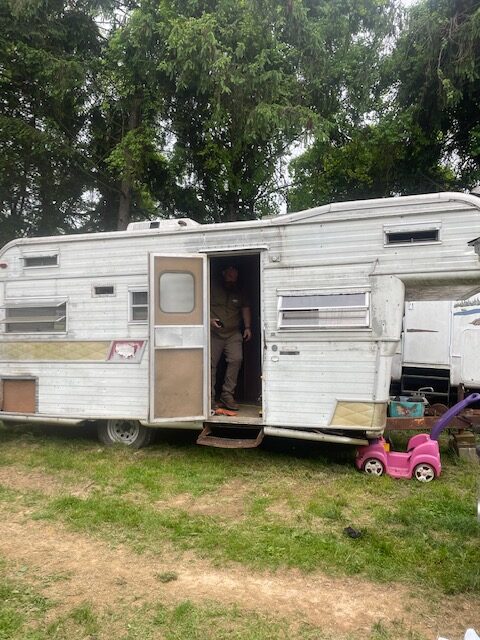Raising Meat Turkeys in the Woods: Create Food Security with the Space you Have!
Current times are unsettling. Food prices are soaring. Gas prices are soaring. Some months, as least for us, it seems like the numbers just don’t add up. Between utilities, food, fuel, and everything in between, money has to be stretched as far as possible.
If you are already canning food from local farmers, growing your own food and canning it, maybe freeze drying or dehydrating food – that is a great start!
Have you thought about raising your own meat? Raising turkeys is cost effective and easy.
Everyone considers laying chickens to be the gateway animal. You setup a little coop and run, and in about 6 months from chicks, you get eggs. Also – a great start to raising your own food!
If you’re ready to take your food security to the next level, you should think about raising meat turkeys. In this blog, we’ll talk about the cost of raising turkeys, raising turkeys in the woods, and raising turkeys with chickens.

Raising Meat Turkeys in the Woods: Are they better than raising meat chickens?
When people talk about “meat chickens,” they are almost always talking about Cornish Cross Chickens. These are the most commonly raised meat chickens in America and around the world, and it’s what you would buy at the grocery store, most likely. Large breasts, and they grow fast.
Cornish Cross Chickens cannot breed by themselves. They have to be artificially inseminated. The same is true about Broad Breasted White Turkeys. Both are bred to grow quickly and get large.
How much does it cost to raise a turkey from birth to processing?
Dollar for dollar, we feel like turkeys make more sense than chicken. Broad Breasted White Turkeys will get to about 15-25 pounds. Females are usually 15-20 pounds, and males are usually 20-25 pounds. When we got our turkeys butchered last year, ours ranged from about 18-25 pounds.
So what is the cost of raising turkeys for meat? When we figured out how much we spent on feed and butchering, we averaged $3-4 a pound, and I suspect even with the 40% rise in feed prices this year, we will round out to about the same. Maybe closer to $4. BUT this is still significantly cheaper than “free range” turkey you find at the grocery store, and you actually know where the meat came from.
As far as chickens versus turkeys, we feel like raising the 16 turkeys we have this year is much more efficient than say raising 30 meat chickens. Now – we ARE raising 30 meat chickens because we want to fill the freezer. BUT if you’re deciding between raising 5 turkeys or 20 meat chickens, for instance, obviously the 5 turkeys are less work. With 5 turkeys, you should get approximately 100lbs of meat or so.
With 20 meat chickens, you’ll get that same 100lbs of meat approximately. But – 5 birds is less animals, if you have restrictions, it’s less roosting space, it’s less all the things. Turkeys do take up more space because they’re bigger, but it’s really not that much space. They cram together on roosting bars just like chickens.
We recommend checking out Murray McMurray Hatchery for your chicken and turkey needs.
Raising Meat Turkeys in the Woods: What do I need to get started?
You will need to show them the water, and you’ll need to show them the food. Put their beaks down into the water and the food gently. Help them learn how to drink and eat.
We personally do not put our turkey poults and chicks together, but that’s usually just because the brooder isn’t big enough to hold them all.
The basics are simple: shelter, water, food, heat.
You can also use a plastic tub, a large wooden box (though these can get wet and rot quickly), or any other vessel that safely could hold the birds.
When you get your brooder, you need to line the bottom with something. We use pine shavings that we buy in bulk for the laying hens and whatever meat birds we are raising at the time. Some people use newspaper, though we are not fans of this method because the birds can slip and hurt their legs at a young age.
Food, Water, Grit
Once you cover the bottom with shavings or your preferred covering, you just need to set up water, food, and grit. We use the standard clear and red containers that you find at a farm store for food and water, and we use a cut aluminum can with a magnet to hang grit on the side of the brooder. We typically rig the water and food to the ceiling with paracord because this keeps bedding out of the water and food. You don’t have to do this, but it does save time.
Heat
You will also need a heat lamp. We also rig this up with paracord because you have to be able to adjust the heat. Birds (turkeys or chicks) need to start their first week around 95-100 degrees. You will decrease their heat by 5 degrees every week till about 4-6 weeks depending on the temp of where you’re raising them. If you’re raising them in a garage that’s hitting 80 degrees during the day, you could probably turn the lamp off during the day once they’re a few weeks old. If it’s the middle of February, you’ll want to keep the lamp on all the time.
We recommend using red lights instead of clear. Clear lights encourage birds to peck at each other, and red doesn’t usually cause this problem.
Heat lamps are available at your local farm stores, and we always keep extra red bulbs on hand. It never fails that one breaks – and it’ll happen at the least convenient time, like a Sunday night, when nothing is open.
A thermometer is optional, I guess, but it would be super helpful in making sure that your brooder stays at the temp it needs to be at. We use the kind that hangs and attach it to the side of the brooder with a magnet.
We raise turkeys from March to October or so. This allows us to brooder when it’s cold, and then by the time they go out, the weather has generally warmed up.

Raising Meat Turkeys in the Woods: Unconventional Methods of Raising Turkeys
When you don’t have “ideal” conditions, though, you have to get creative.
So – do turkeys need a coop?
The Holiday Rambler camper you see pictured above is one of our brooders/coops. We are currently broodering chickens and heritage turkeys in this camper. Its ultimate purpose will be to hold the heritage turkeys and be their coop. We spent $50 on this camper on Facebook Marketplace, and we added a couple hundred dollars to it in wood and screws to get it up to snuff.
My point is: you don’t have to buy a $3000 chicken coop to raise your own meat.
Can you repurpose a shed? Fix up a coop you find on local yard sale sites? Find a crappy camper and make it work?
Turkeys are great. They have so much personality, and as long as you feed and water them, and they are safe from predators, they will be happy. You will get a ton of meat, and your self reliance is increased.
As far as fencing, we use fencing from Premier One. This allows us to setup the fencing even if we don’t have power ran to that area. The solar charger doesn’t really even need direct sunlight. Ours get some morning direct sun, but it mostly gets indirect light during the day.
Raising Meat Turkeys in the Woods: Building a Roosting Bar Structure
It was 16- 2×4’s, 3″ screws, and some carriage bolts. The whole thing cost us about $125 at the time of this post. The feeder can hang from it, and you can adjust the foot spacing with the middle supports.
Raising Meat Chickens in the Woods: A Few Last Tips for Success
2. Before you setup your Premier One fencing, you should weedeat the area. The fencing will keep a much better charge if it’s not fighting against a bunch of brunch. Obviously you want to keep as much good foliage for the turkeys to forage through as you can, but clearing the path where the fence goes will make a big difference in your animal security.
3. We feed 28% wild game bird starter when we get meat turkeys. We usually leave them on that for about 6 weeks, and then we switch them to 21% Fast Grow feed, which is basically a grower pellet.
4. Turkeys LOVE garden scraps! We love raising turkeys in the spring/summer/fall because they help eat up garden scraps, along with the laying hens.
5. My last tip – and always the burning question is – When Raising Turkeys for Meat How Long Does it Take?
Most people raise turkeys for about 6 months, and then it’s time to butcher. This will yield amazingly tender meat, and our favorite way to enjoy our homegrown turkey is on the smoker!
Raising Meat Turkeys in the Woods: Enjoy a More Sustainable Life!
We enjoy raising meat turkeys in the woods because it helps us make the most of our space here on 3 acres. We don’t have pasture, so we have to get creative. Raising meat turkeys in the woods also gives us the flexibility to use our “open” land for gardening and raising plants that have to have full sun.
Let us know how your experience with raising turkeys goes!

